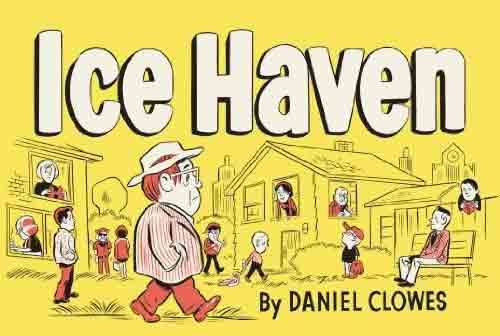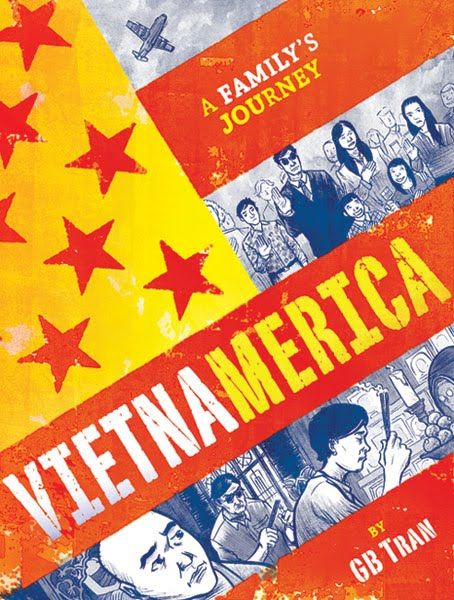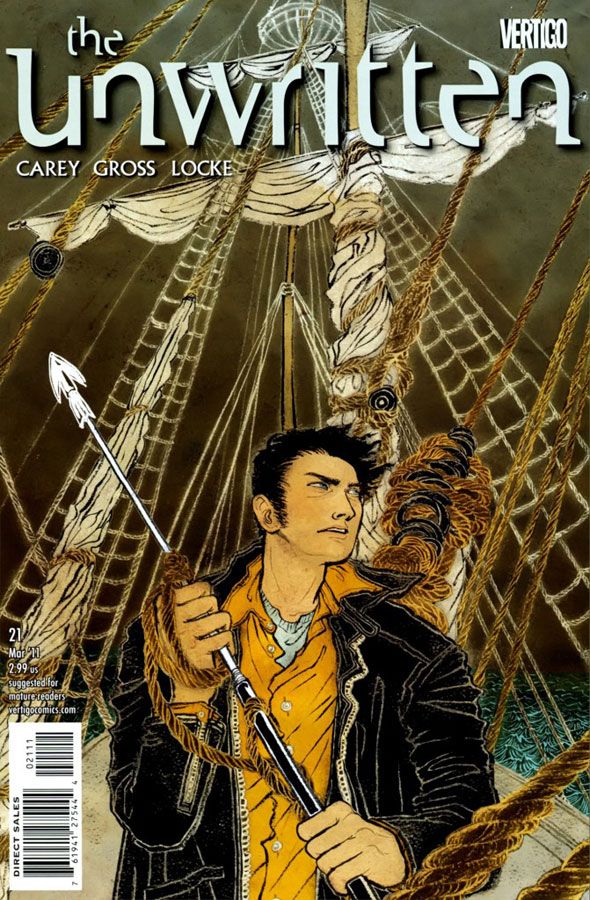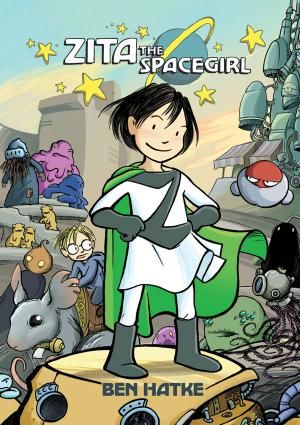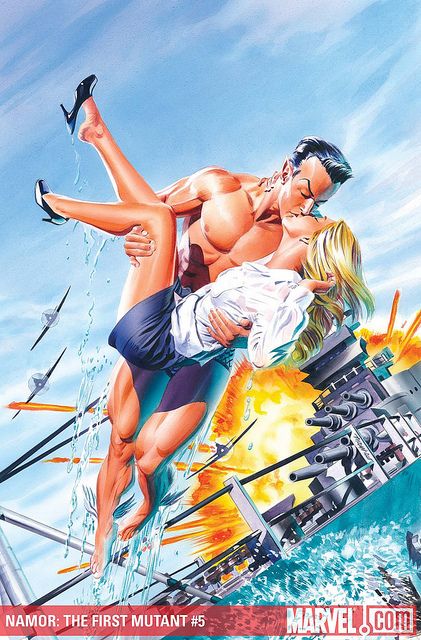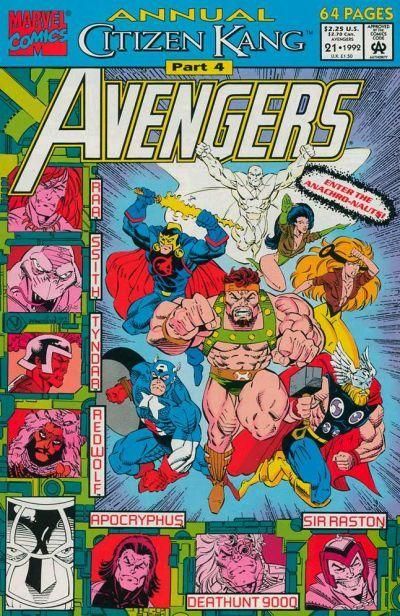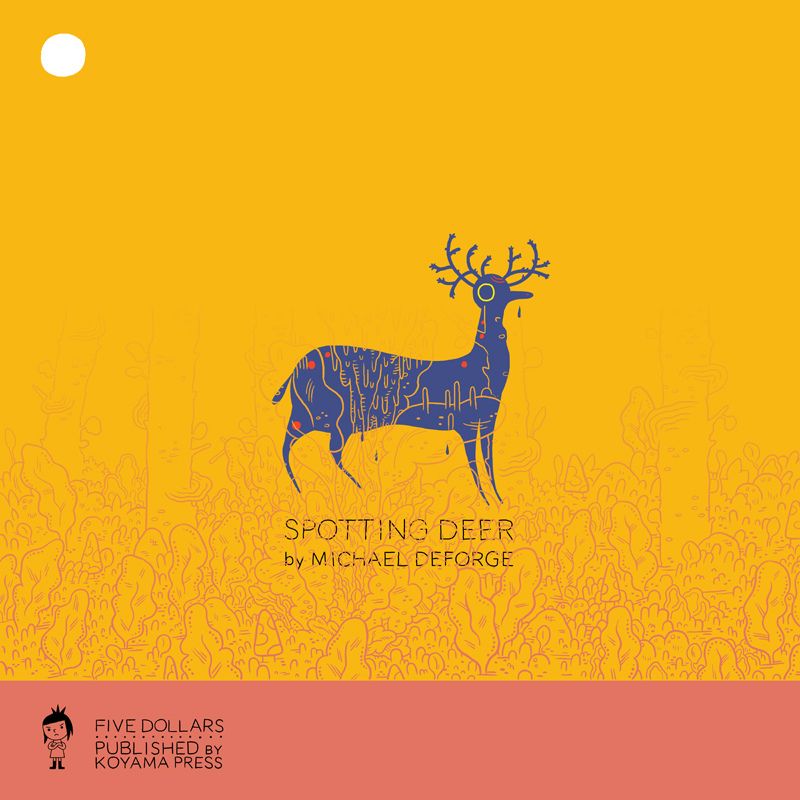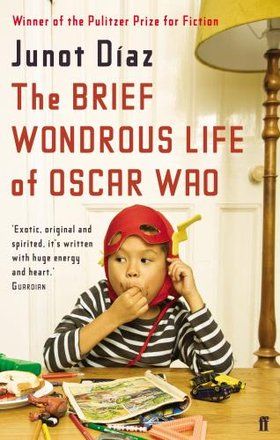Welcome to a special Super Bowl Sunday edition of What Are You Reading? Not that it's any different from a regular WAYR column, but you can enjoy it while eating hot wings while the TV is paused.
Today our special guest is biology professor Jay Hosler, creator of Clan Apis and Optical Allusions. His latest book, Evolution, with artists Kevin Cannon and Zandor Cannon, was recently released by Hill & Wang. Check out his blog for a story he's working on about photosynthesis.
To see what Jay and the Robot 6 gang are reading, click below.
*****
Chris Mautner
I just re-read Daniel Clowes' Ice Haven again, as Pantheon was kind enough to send me the new paperback version. It's as enjoyable and tart a read as ever, but it does strike me as just a wee bit dated in that it was clearly written in a time before the Internet and similar kinds of technology became ubiquitous (one character even complains about no one reading her 'zine for instance. Remember those?) The loneliness and alienation the characters seems slightly quaint in an age where everyone can find someone who shares their interests and can keep in touch with just about anyone who has a computer, regardless of how far away they are. These folks are just one Facebook account and Twitter feed away from solving their problems.
Tom Bondurant
This week I'm very glad for the time to re-read all 21 issues of The Unwritten, Mike Carey and Peter Gross' exploration of literature's interaction with reality. Although I've been keeping up with the single issues, this was the first chance I'd had to sit down with the series as a whole. Overall it was pretty rewarding, because the series works on so many levels. (That was a nice James Whale reference in issue #21!) I also found myself more engaged with the characters, especially Lizzie and Savoy. However, since each issue encourages multiple readings (not just the clever multipath #17), I think Unwritten may be read best in singles. As much as I liked being able to consume whole story arcs at once, it'll be nice to have a month to reflect between installments.
(By the way, another series with which I'd like to spend more time is Neal Adams' Batman: Odyssey -- mostly because I have no idea what's going on. This past week's issue #6 complicated things further with Deadman inside the Joker's body, with Adams not really making it clear where the villain might be regaining control. The alternate
Dynamic Duo were kind of intriguing, though.)
Speaking of time between issues, I thought Amazing Spider-Man was going back to a monthly schedule once the rotating creative teams were done. This week's #653 (by Dan Slott and Stefano Caselli) was quite fun, especially Squirrel Girl's cameo as "Earth's Mightiest Nanny." Caselli's work was fine, and I can see a few stylistic similarities between it and Humberto Ramos', but I don't know if Marvel is trying to establish an overall aesthetic for ASM with a particular set of artists. Not a criticism, just an observation. I am still getting used to the idea of Spidey as an Avenger, and while Slott has already used them in "Big Time," this issue really showed how comfortable Spidey is with his teammates. Looking forward to #654 in just a few short days.
Finally, I really enjoyed the 2011 Superman 80-Page Giant, and I'm not just saying that for Abhay's benefit. (I too figured out the twist in his Jimmy Olsen story, but a) that was probably the point, and b) it was still a good Jimmy/Superman story.) Neil Kleid and Dean Haspiel's Perry White/Wildcat team-up was a nice little bit of history, Steve Horton and Dan McDaid's Bizarro story was sweet and fun, and the Lois Lane story (written by Paul Tobin and Colleen Coover, drawn by Amilcar Pinna) was yet another good reason to give DC's greatest reporter her own feature. All in all, not a bad way to spend $6.
Brigid Alverson
I'm reading two graphic novels right now that deal with well-worn storylines but manage to freshen them up a bit. Ben Hatke's Zita the Spacegirl is about a girl who watches her friend get snatched through a rip in the real world and goes in after him. On the other side of the portal is a strange world filled with an assortment of muppetlike aliens (many of whom, oddly, speak English). It's a hostile world and also a doomed one‹an asteroid is on track to hit it in just three days. The inhabitants' attempt to deflect the asteroid has gone terribly awry, causing destruction and destabilization. Zita stumbles into this and, in true adventure-tale fashion, soon acquires a cohort of friends, a group blessed more with loyalty than skill, it must be said. Much of the charm of this book comes from Hatke's simple but expressive line and also imaginative cast of characters. The aliens come in a true variety of shapes and temperaments, from the aptly named Strong-Strong to One, a round, maladroit flying robot. The plot follows the standard pattern of these books‹the quest, the double-cross, the epiphany‹but the ending is a bit of a surprise.
The first volume of Julietta Suzuki's Kamisama Kiss presents the reader with a whole bouquet of shoujo-manga clichés, starting with the the irresponsible father who abandons his daughter, the plucky Nanami. You would think from reading shoujo manga that Japan has no child welfare system whatsoever; Nanami heads off to sleep in a nearby park but ends up rescuing a stranger who has been chased up a tree by a dog. The grateful stranger offers her his home, which he has not visited in 20 years, but upon arrival Nanami discovers that the home is actually a Shinto shrine, and she is now the resident deity. She is, of course, terribly unqualified for the job, and the hot-but-hostile Tomoe, the last deity's helper, is in no mood to make things any easier. Although these elements show up in a lot of shoujo manga, Suzuki spices them up with a liberal dose of humor and Japanese folklore, as well as a plot that doesn't fall into place right away but keeps Nanami's situation unstable‹and therefore interesting.
Michael May
I blew most of my reading time this week on non-fiction, but I did squeeze in Namor #5 to see what Marvel's doing with THEIR underwater superhero these days. I know it's not the most recent issue (#6 is next in the pile), but it was a great introduction to the character and his world. Artistically, they should've skipped the introductory X-Men crossover story arc and started with this one. Stuart Moore does a nice job of highlighting the many moods of Sub-Mariner and how he's been perceived in such different ways throughout his career, while also reconciling those "faces" (as the story is titled) into a single personality. And as he does this, he shows off too some supporting cast and teases an interesting direction for future issues. I'm eager to read more.
Tim O'Shea
The first Mermin arc from Joey Weiser comes crashing (and I mean crashing in giant waves crashing) to an end with issue 5. It's a heck of a finish that entertained my 11-year old son immensely (as well as myself). This story is at its best when Mermin is bantering with his old and new friends, the character is an odd mixture of innocence and snark--a combination I enjoy.
I hate, hate, hate spending $4 on a single comic--and had convinced myself that I could wait for trades on Dan Slott's Spider-Man. But dangit if the latest cover did not draw me in (plus the ever-fleeting opportunity to see Slott write Thing dialogue yet again {yeah, I'm the guy that loved Slott's Thing ongoing series from a few years back}). I really hope Max Modell is not some evil genius about to turn on Parker, because after reading just a few scenes with the guy, I like him already. And that's a credit to how great Slott is at writing characters that immediately catch the audience's interest. Bonus points for the banter between Spidey and Squirrel Girl.
Paul Tobin's really hitting his stride as a writer with Spider-Girl. Death appears to be final (no surprise returns) in this series, and I think the book's a must read for the ways that Tobin addresses the grieving process without being heavy handed. I really hope Marvel editorial will allow Sue Richards to continue to play a role in this book, as the dynamics are a departure from what I've grown to expect in Marvel.
It took until Hulk #29 for me to finally realize artist Gabriel Hardman could draw a bunch of characters picking their noses and I would still love his work. There's an energy and a dynamic sense of layout to his work that is rarely present in monthly comics. Added bonus, Jeff Parker's script is far more than people probing their noses.
Carla Hoffman
I've been reading some weird comics. Sure, there's Invincible Iron Man #500.1 we could talk about, but why do that when I can tell you I read Avengers Annual #21! Part 4 of the Citizen Kang storyline that ran through a handful of annuals back in 1992, this particular issue caught my eye while shelving the Citizen Kang trade. Our store is stocked lovingly with back issues, I hunted this one down and tried to take a single part out of an old school event and see how it compares. First off, the art is both terrible and beautiful, like the dawn; everybody is yelling, noses could slice the finest cheese, implausible anatomy at stake in some cases, this is not the masterwork of the ages. But yet, the story is easy to follow, pictures depict the narrative and there's even this cute trick of Thor casually leaning on the next frame on the page. The story, while full of adorably hokey lines, is pretty straightforward, Kang is fighting the Avengers when his girlfriend in suspended animation throws an M. Night Shyamalan twist and in the end, we all learn that while we fight to conquer the future, the past is never that far behind. Really, it's not half bad and more than half fun, so find an issue when you can. I grabbed it mostly for the extras: more specifically, the secret details of an Avengers Membership card (a homing beacon strong enough to carry over "approximately 2000 miles", a debit card function that will let Avengers draw "up to $2,500 against the Avengers account", that it's a key card not just to the locks inside top secret sections of the mansion, but the key to a lot of Avengers vehicles as well, that it has a calculator function, etc.). I love old maps and technical stats the from the Old OHotMU days, so this annual was a special treat.
I also re-read Avengers #72 to be exact, but more importantly refreshed myself on the Search for She-Hulk storyline, written before Geoff Johns had settled in with the Distinguished Competition. This issue is just 28 issues away from Disassembled and there are moments that feel like you're in the Twilight Zone (Sterling style, not Pattinson). A rather complicated and in-depth plot explained quickly: Jennifer Walters has been forced into her puny form and is terrified for the first time in a long while. She heads out into the middle of nowhere to find her on-the-run cousin, Bruce, wracked with self-doubt. The Avengers catch up with her and the Scarlet Witch confesses to the de-powered Jen the following about her powers "Sometimes, I feel like all of this negative energy sends my head spinning, too. Sometimes, I feel that sometimes I can do nothing but perpetuate the unnatural." But there's a strong and immediate bright side to this instability: the Avengers. "But the Avengers are there to ground me. To help me bring order to my life. They are good friends, Jennifer." Sometimes, reading old comics just makes you miss those friends, We're still pulling for you, Wanda.
Sean T. Collins
Self-published comics and YA genre fiction were my stock in trade this week. Click the links for full reviews!
Snake Oil #6: The Ground Is Soft by Chuck Forsman: Weeks after I first read it, I'm still thinking about this bleakly funny, innovatively structured look at a dysfunctional family struggling against the strictures of their just-this-side-of-a-fantasy-world society.
Studygroup12 #4 by various artists, edited by Zack Soto (self-published): Lovingly printed and stunningly colored, this anthology makes for a fine catalog of art from a mostly Left Coast, Portland-centered group of altcomix artists, but it left me hungry for more substantial comics content.
Spotting Deer and SM by Michael DeForge (Koyama Press/self-published): Two visually inventive, narratively twisty, entertainingly unpleasant horror comics from one of the brightest young talents in alternative comics today.
Finally, I also wrote about a batch of young-adult fantastic-fiction books I've read in recent weeks: Susan Cooper's The Dark Is Rising Sequence, Lloyd Alexander's Prydain Chronicles, and Suzanne Collins's The Hunger Games. The job of books like these is first and foremost to succeed as exciting reads, and that they do, but it's even more fun to pick at their underlying moral themes, and see just how different they can be.
Jay Hosler
The first few weeks of the year are always a good time because I get to read all of the stuff I got over the holidays.
The only novel on my list is The Brief Wondrous Life of Oscar Wao by Junot Diaz. What a terrific book. The fanboy elements added to the fun, although given the number of references I missed, I'm worried my geek quotient isn't as high as it used to be.
In the graphic novel/collection category I recently received a copy of GB Trans Vietnamerica. Whoa. Be-A-utiful book. I had the pleasure to sit by GB at the last SPX and he is not only a great artists and writer but a really nice guy. Everyone should buy this book. I got my monthly Tezuka fix with Ayako, Blackjack (vol 11) and The Art of Osamu Tezuka by Helen McCarthy. The latter contains drawings from Tezuka's childhood including hand painted insect guides that are gorgeous. He loved beetles. That's my kinda cartoonist. I also had a chance to read Aya: The Secrets Come Out by Marguerite Abouet and Clément Oubrerie (I hope there is a fourth volume coming out soon) and the first two Parker books by Darwyn Cooke. They are an interesting contrast; Aya's airy, colorful Ivory Coast versus the monochormatic, mean streets of Parker. My son's got The Saga of Rex by Michel Gagne and they were kind enough to share it with me after they were done pouring over the lush illustrations.
I still pick up my monthly does of adventure comics from The Comic Swap in State College, PA. One of my all-time favorites is Usagi Yojimbo. Stan Sakai's ability to deliver funny, exciting, touching stories every month is astounding. I want to be just like him some day. I started picking up Ed Brubaker's Captain America when Steve Rogers was shot. It was topical and I was teaching a course called Comics and Culture at the time and the stories hooked me. I am also trying Hulk by Jeff Parker because I think Jeff Parker is the mega cool. I loved the fun of Agents of Atlas and decided to give Hulk a go. I was pretty certain I wouldn't stick with it because the character doesn't really interest me much, but Parker's imagination for writing science fiction (emphasis on the science) has sucked me in. Finally, I started picking Thor: The Mighty Avenger because Roger Langridge and Chris Samnee are an exciting creative team. I'm sad to see that book go.
Of course, I can't forget the books I read aloud with my sons, Max and Jack. We finished The Lost Hero by Rick Riordan and The Wainscott Weasel written by Tor Seidler and illustrated by Fred Marcellino (such pretty picture). Both were a blast to read aloud. We are currently reading the Minpins by Roald Dahl. And that brings us to the non-fiction part of the show.
I am making my way through Storyteller, Donald Sturrock's autobiography of Roald Dahl and finding it very interesting. I recently finished Proofiness (Charles Seife's exploration of our cultures growing innumeracy and how it is effecting democracy) and I'm also picking my way through Adventures Among Ants by Mark W. Moffet and Sensing the Past: Seeing, Hearing, Smelling, Tasting, and Touching in History by Mark J. Smith.
Good times.

